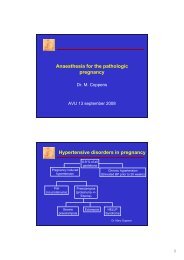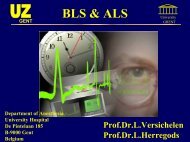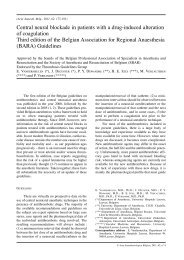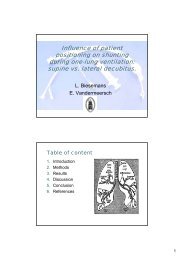Combined spinal epidural analgesia for labor and delivery
Combined spinal epidural analgesia for labor and delivery
Combined spinal epidural analgesia for labor and delivery
You also want an ePaper? Increase the reach of your titles
YUMPU automatically turns print PDFs into web optimized ePapers that Google loves.
114 M. VAN DE VELDE<br />
rate <strong>and</strong> in increased Cesarean section rate.<br />
Extensive research has now led to unanimous consensus<br />
that <strong>epidural</strong> <strong>analgesia</strong> does not produce<br />
more instrumental vaginal <strong>and</strong> operative deliveries.<br />
However, <strong>epidural</strong> <strong>analgesia</strong> prolongs the duration<br />
of the first stage of <strong>labor</strong> <strong>and</strong> increases the need <strong>for</strong><br />
exogenous oxytocin.<br />
TSEN et al. demonstrated in a prospective,<br />
r<strong>and</strong>omized trial that CSE is associated with an<br />
increased cervical dilation rate. Patients r<strong>and</strong>omized<br />
to CSE <strong>analgesia</strong> experienced a doubling of the<br />
mean cervical dilation rate <strong>and</strong> a reduced duration<br />
of the first stage of <strong>labor</strong> as compared to <strong>epidural</strong><br />
<strong>analgesia</strong> (157). Several mechanisms have been<br />
proposed to explain these observations. First,<br />
CSE rapidly reduces epinephrine plasma levels.<br />
Since epinephrine is tocolytic (147), CSE quickly<br />
enhances uterine activity. Since <strong>analgesia</strong> <strong>and</strong> plasma<br />
epinephrine lowering occur much more rapidly<br />
than with conventional <strong>epidural</strong> <strong>analgesia</strong>, progression<br />
of <strong>labor</strong> could be enhanced. Second, since high<br />
doses of local anesthetics are avoided with CSE, the<br />
in vitro <strong>and</strong> in vivo observations that bupivacaine<br />
impairs uterine activity are also avoided (74, 171).<br />
Disappointingly, several r<strong>and</strong>omized trials comparing<br />
CSE with conventional <strong>epidural</strong> <strong>analgesia</strong> could<br />
not demonstrate a difference in <strong>labor</strong> duration (37,<br />
109, 159, 162).<br />
As compared with low dose <strong>epidural</strong> strategies,<br />
CSE was not associated with an increased<br />
spontaneous vaginal <strong>delivery</strong> rate in most trials (36,<br />
37, 47, 109, 132, 159, 162). Only one trial reported<br />
less instrumental vaginal deliveries with CSE than<br />
with <strong>epidural</strong> <strong>analgesia</strong> (100).<br />
Fetal heart rate changes<br />
Abnormal fetal heart rate recordings <strong>and</strong> fetal<br />
bradycardia are worrisome side effects that may follow<br />
any type of effective <strong>labor</strong> <strong>analgesia</strong>. WONG et<br />
al. reported more abnormal cardiotocographic readings<br />
following CSE as compared to systemic <strong>analgesia</strong><br />
(173). Some authors reported that this complication<br />
could be more common following intrathecal<br />
opioids than following conventional <strong>epidural</strong> <strong>analgesia</strong><br />
(28, 29, 72, 79). CLARKE et al. were the first to<br />
describe in detail the association between intrathecal<br />
opioids, uterine hyperactivity <strong>and</strong> fetal bradycardia<br />
in the absence of maternal hypotension (28).<br />
Since then, several non-r<strong>and</strong>omized trials have evaluated<br />
the incidence of fetal heart rate changes following<br />
either intrathecal opioids or conventional<br />
<strong>epidural</strong> <strong>analgesia</strong> (106, 122, 161, 163). NIELSEN et<br />
al. <strong>and</strong> EBERLE et al. did not observe an increased<br />
Table 2<br />
Incidence (%) of fetal heart rate abnormalities following CSE<br />
or conventional <strong>epidural</strong> <strong>analgesia</strong> as reported using a nonr<strong>and</strong>omised<br />
study design.<br />
CSE<br />
Conventional <strong>epidural</strong><br />
NIELSEN 1996 (106) 15.4% 18.8%<br />
EBERLE 1998 (48) 3.9% 3.9%<br />
KAHN 1998 (75) 5.6% 2.5%<br />
PALMER 1999 (122) 12% 6%<br />
VAN DE VELDE 2001 (163) 11.4% 5.9%<br />
incidence of fetal heart rate abnormalities, whilst all<br />
other non-r<strong>and</strong>omised reports noted at least a doubling<br />
of the incidence of worrisome fetal heart rate<br />
changes (5) (Table 2).<br />
MARDIROSSOF et al. per<strong>for</strong>med a meta analysis<br />
of several prospective trials comparing intrathecal<br />
opioid <strong>analgesia</strong> with non-intrathecal opioid <strong>analgesia</strong>,<br />
with respect to fetal bradycardia (93). These<br />
authors concluded that intrathecal opioids were<br />
associated with significantly more fetal heart rate<br />
abnormalities. Vercauteren suggested that the incidence<br />
of fetal bradycardia depended on the dose of<br />
the intrathecal opioid (165). VAN DE VELDE et al.<br />
per<strong>for</strong>med a prospective, r<strong>and</strong>omized trial that was<br />
specifically designed to evaluate the effects of<br />
intrathecal opioids on the incidence of worrisome<br />
fetal heart rate changes (162). These authors concluded<br />
that high doses of intrathecal opioids<br />
increased the incidence of fetal heart rate abnormalities<br />
despite a reduced incidence of hypotension.<br />
Similar results were published by NICOLET et<br />
al. (105). These authors also indicated that older<br />
age <strong>and</strong> higher VAS scores prior to <strong>analgesia</strong> were<br />
risk factors of fetal heart rate abnormalities after<br />
CSE. Gaiser suggested that the risk of fetal heart<br />
rate abnormalities is increased when the fetal head<br />
is not engaged or when decelerations are already<br />
present prior to the initiation of <strong>analgesia</strong> (56).<br />
The presumed mechanism of opioid induced<br />
non-reassuring fetal heart rate tracings is uterine<br />
hyperactivity caused by a rapid onset <strong>analgesia</strong> <strong>and</strong>,<br />
as a result, a rapid decrease in maternal circulating<br />
cathecholamines. Based on <strong>labor</strong>atory investigations<br />
by SEGAL et al., increased myometrical tone<br />
<strong>and</strong> increased uterine vascular resistance may be<br />
caused by the decrease of epinephrine levels in the<br />
continuing presence of high norepinephrine levels<br />
when CSE <strong>analgesia</strong> is per<strong>for</strong>med (26, 147). ABRAO<br />
et al. recently measured uterine tone using an<br />
intrauterine pressure catheter following either CSE<br />
or conventional <strong>epidural</strong> <strong>analgesia</strong> (2). Fetal heart<br />
rate changes <strong>and</strong> uterine hypertonus occurred more<br />
© Acta Anæsthesiologica Belgica, 2009, 60, n° 2
















